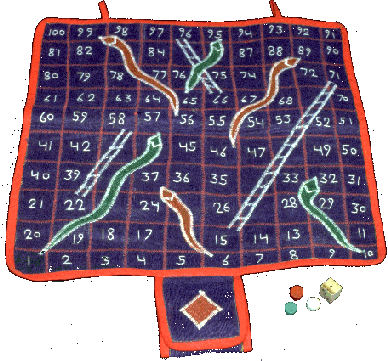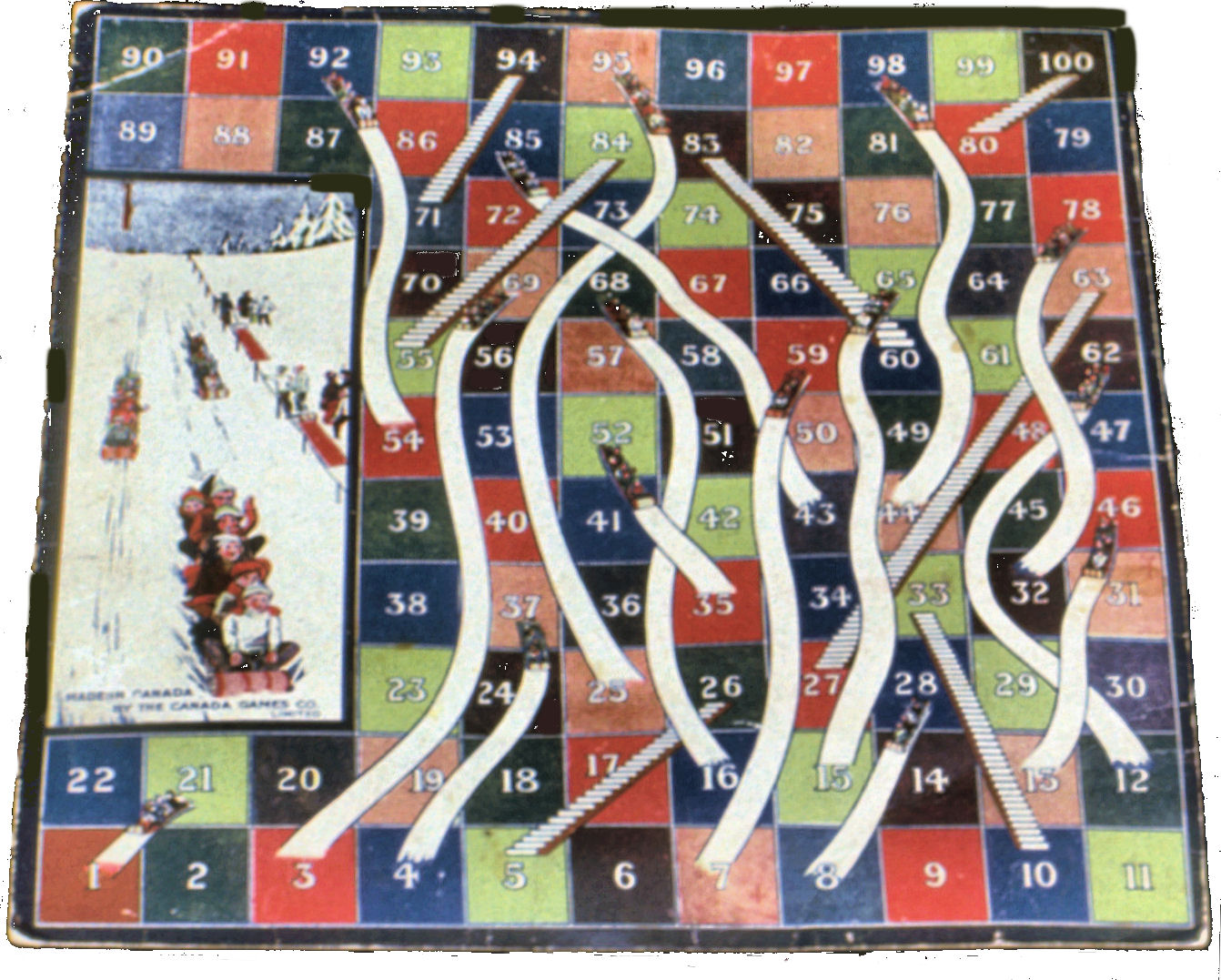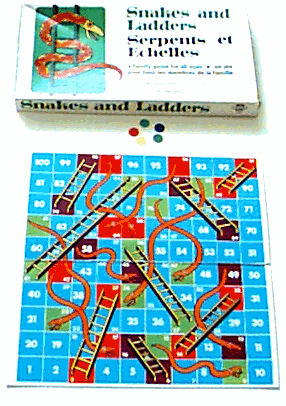
The origins of this game appear to be found in 2nd century BC documents from India. Some historians point out that the game may be a variation of the ancient game of dasapada played on a 10x10 grid. Some say the game was developed by religious teachers who used the game to teach children the difference between "good and evil". In any event, the British "discovered" the game during the "Empire" days and introduced it into England in the 1890s, and eventually it was marketed as a children's game. According to Whitehill, the American version is known as Chutes and Ladders and first appeared in the US in 1943.
The photograph above is a handmade copy of the game from Bangladesh, purchased in Canada in 1981. The fabric "board" is 47.5 cm long x 46.2cm wide. There are 100 squares stitched into the fabric in a 10x10 pattern. Numbers are sewn into each square. The specific number placed in each cell may be traditional or may be at the discretion of the maker. Across the squares, 3 white ladders and 6 snakes are sewn. At the top, two loops are attached, and at the bottom a flapped pouch (which holds the playing pieces) is attached. The playing pieces consist of 4 wooden pawns and one wooden die. The entire board may be rolled up for storage. The top loops hook onto 2 buttons sewn on to the back in order to hold the rolled board closed.
A cloth board with stitched components is common on the Indian subcontinent, and has been since at least the period of the Mogul Empire. In the past, such cloth game boards of this type and for other games were carefully crafted by young girls as part of a trousseau to be taken to their new husband's home. When a girl came from a wealthy family, threads of gold were often sewn into the pattern.

The game is for 2 to 4 players, and is typical of "racing games" which are based upon a chance factor. In this game - a die. The intent of the game is for one of the players to reach the end of the board before any other player. A player rolls the die and moves a counter the number of squares indicated by the die. Moves may enable a player to climb a "ladder" or "slither like a snake" - altering the distance to be traveled through the matrix. Travel is according to the numbers stitched on the "board".
The photo above is an early 20th century Canada Games Company "Snakes and Ladders" game with an "environmental modification". In typical Canadian fashion, the game illustrates children (in the rectangle on the left of the board) on toboggans in the snow. Instead of "snakes" or "ladders", the board features "toboggan runs". However, the game is the same as the cloth one pictured above, except for one design factor - this board features an 11x11 matrix. This copy was donated to the collection in 1982, along with an other early 20th century version with the name "Ski Hill" (not illustrated on this page).

Another early version of this game in the collection is pictured on the right, and illustrates the trials and tribulations of a boy and girl as they make their way in and out of a British railroad station and a train. In one panel they appear to be directed by a British Bobbie! The game matrix is 10x10 and includes a similar configurations of "snakes" and "ladders". The boy and girl are attempting to reach their destination at the bottom right of the board.
Note the differences among the boards on this page. The cloth board and the "ski" board only include numbers on the cells in the matrix. This British board includes a range of cartoon graphics which add interest for the youthful players of the game.
The following two games from Canada appear to observe both conventions - one with only numbered cells, and the second with graphics in some cells.

The photograph of the game on the left is of a contemporary version of the same game. Also manufactured in Canada, the game has instructions in both the English language and the French language. Note that the board has been modified and only includes 90 squares - a 10 x 9 grid.
The board has 8 "ladders" and 10 "snakes", all of which look exactly like snakes or ladders! It is apparent that these games were intended for use of children, rather than adults, based on their design and the modification of the board. Less squares to traverse on the board shortens the game somewhat, and makes it easier for young people to play. When compaired with the much earlier "ski hill" version, there are far less snake and ladder connections on the board.

The game pictured at the right is yet another contemporary version of the same game, also manufactured by the Canada Games Company, Ltd. The game has instructions in both the English language and the French language.
In both of these contemporary versions of the game it is obvious that a player may find that they land on a "snake" or a "ladder" that will not take them forward toward the "finish", but rather will put them back to an earlier place on the board. (This latter factor may indeed have been used in the past to teach the "moral" consequences of certain behaviors!)
Note also in this version of the game, there are more explicit graphical images on the board. The designer of this version thought that perhaps these images (rather than different colored squares) would make the game more interesting for the young players!
Last update March 4, 2010